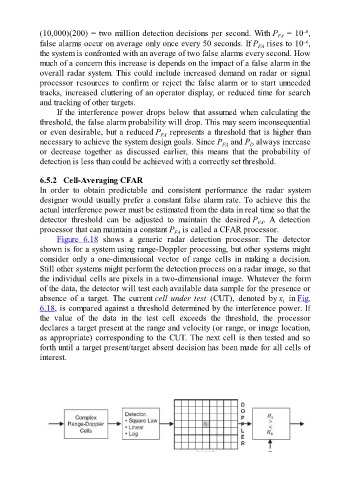Page 499 - Fundamentals of Radar Signal Processing
P. 499
–8
(10,000)(200) = two million detection decisions per second. With P = 10 ,
FA
–6
false alarms occur on average only once every 50 seconds. If P rises to 10 ,
FA
the system is confronted with an average of two false alarms every second. How
much of a concern this increase is depends on the impact of a false alarm in the
overall radar system. This could include increased demand on radar or signal
processor resources to confirm or reject the false alarm or to start unneeded
tracks, increased cluttering of an operator display, or reduced time for search
and tracking of other targets.
If the interference power drops below that assumed when calculating the
threshold, the false alarm probability will drop. This may seem inconsequential
or even desirable, but a reduced P represents a threshold that is higher than
FA
necessary to achieve the system design goals. Since P and P always increase
D
FA
or decrease together as discussed earlier, this means that the probability of
detection is less than could be achieved with a correctly set threshold.
6.5.2 Cell-Averaging CFAR
In order to obtain predictable and consistent performance the radar system
designer would usually prefer a constant false alarm rate. To achieve this the
actual interference power must be estimated from the data in real time so that the
detector threshold can be adjusted to maintain the desired P . A detection
FA
processor that can maintain a constant P is called a CFAR processor.
FA
Figure 6.18 shows a generic radar detection processor. The detector
shown is for a system using range-Doppler processing, but other systems might
consider only a one-dimensional vector of range cells in making a decision.
Still other systems might perform the detection process on a radar image, so that
the individual cells are pixels in a two-dimensional image. Whatever the form
of the data, the detector will test each available data sample for the presence or
absence of a target. The current cell under test (CUT), denoted by x in Fig.
i
6.18, is compared against a threshold determined by the interference power. If
the value of the data in the test cell exceeds the threshold, the processor
declares a target present at the range and velocity (or range, or image location,
as appropriate) corresponding to the CUT. The next cell is then tested and so
forth until a target present/target absent decision has been made for all cells of
interest.

